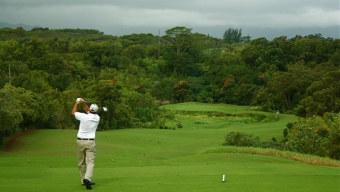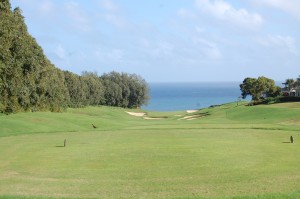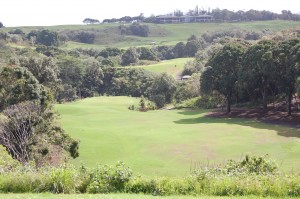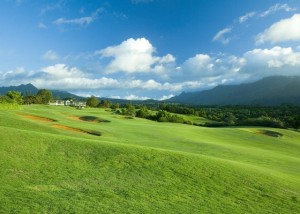Editor’s Note: During this difficult time dealing with the Coronavirus outbreak, leaving golf writers nothing to write about, we decided to revisit some of the places we have gone over the years. Today, we return to Princeville.
PRINCEVILLE, Hi – Your tee shot on the opening hole at the Prince course at the Princeville Resort descends from an elevated tee into a valley bordered by forest so dense you might want to trade your golf cap for a pith helmet.
Welcome to the jungle.
“What we have is the experience and the journey it takes you on, and the shot values,” said T.J. Baggett, the Prince’s general manager. “There’s not a letup hole.”
That 18-hole journey starts you off with a trip down the first fairway (pictured above) below the acacia, eucalyptus and monkeypod trees where you arrive at a green – guarded by a river canyon – that has been cut out of the forest. Along the way you’ll weave in and out of vine canyons and up over rises with glorious ocean views then back through and around some of Kauai’s most lush flora.
Your experience may not quite be fully appreciated until you reach the end of the journey, standing on the 18th tee and taking a 360-degree gaze across the horizon to see the deep canyons and green-ribbon landing strips that you just played.
There’s a reason why the Prince is consistently ranked the No. 1 public course in Hawaii and among the top 100 in the U.S. Actually, there’s a multitude of reasons, especially after its 13-month renovation (January 2010 to March 2011) in which tees were changed, fairways widened and reshaped, bunkers revised and greens resurfaced with an more seawater resistant paspalum grass that’s not unlike putting on artificial turf. Smooth, true and fast.
The guy who did the renovation is the same one who originally designed the course back in 1971, renown course architect Robert Trent Jones, Jr.
“It’s one of his favorite designs to this day,” Baggett said. “He just loves this golf course, loves the design, loves the routing.”
It was one of Jones’ first (of more than 250) projects. He’s also a frequent visitor here to monitor his handiwork, as he has a home in nearby Hanalei.
“We cut away a lot of jungle (during the restoration),” Baggett said. “A lot of holes we cleared out a lot of junk and they found hazard stakes that were 30 yards into the jungle. It had it encroached so badly. We have a four-man crew and that’s all they do (clear), it just grows so fast.”
The site was originally intended to be a private golf course financed by and serving wealthy Japanese businessmen. Private courses generally are much tougher than resort style courses and Jones’ team made sure it was. Eventually, economics forced the transition from private to public but tough remained.
Jones, who also designed the neighboring Makai course and Poipu Bay, likes to place obstacles, such as bunkers, trees and thick brush, coincidentally in your landing areas. Imagine that. He also built in a fair number of blind shots here, such as on the first two holes. The 597-yard par-5 second hole is around 200 yards off the tee to a slope and a thick layer of vegetation that will completely swallow your ball. But you can’t see that from the tee. You have to know it’s there – or see it on the cart’s GPS diagram. Here’s a tip: Pay attention to that GPS, as I should have.
“There are some tricky shots,” Baggett understated. “You have to take what the golf course give you. You have peril in every landing zone. You have to be really careful about the clubs you select and the area you’re hitting.”
By the third hole you emerge from the undergrowth and it opens up for the next few holes. Watch the water all along the fourth fairway.
At the signature-hole candidate par-4, 428-yard sixth hole, you finally see the ocean (left). It’s in the distant horizon as you stare from the tee down a narrow green-emerald chute with a slope on the right and a long row of trees on the left with large patches of sand – seven bunkers – waiting your arrival.
Seven is a beautiful par-3, 207 yards for the long hitters but about 150 to 170 for the rest of us. The green sits out there on a ledge, with a 180-degree eyeful of ocean in the background. Club down here because the prevailing wind is in your face. You have to make good contact because short is big trouble – but also too long puts you in lost-ball jeopardy.
For most of the course, there are not many houses but through this stretch, six, seven and especially eight, you are surrounded by wonderful Hawaii style homes, big balconies and porches and large windows. Just don’t hit one.
As you make the turn, here’s a warning before you play No. 10 – check the GPS. This 588-yard par-5, a severe dogleg left, is another Jones-designed blind tee shots. If you mess up, you’re cooked. It’s really a marvelous hole but you don’t necessarily see that from the tee.
The green is visible to the far left. However, don’t go straight for it. Do not. If you do you’ll have to carry all 588 yards. There is a deep canyon only about 180 yards out, slightly to the left of the tee. If you take it right, you’ll be OK but seemingly going away from the green.
“What a fun hole. Some guys go for it (second shot) but you’ve got to get your tee shot right along that ridge,” Baggett said. “Some think they can, but they can’t.”
It’s about a 200-yard shortcut shot over the canyon to the hole but the prevailing wind is in your face and there’s impenetrable brush bordering the front edge of the green.
“We keep the jungle cut back in there,” Baggett said. “Before the restoration you could not see that green.”
The best play is to cut off as much of the canyon as you can and land it along the fairway that sweeps in from the right.
No. 12, a 390-yard par-4 (right), is perhaps the course’s most memorable hole. You’re back deep into the jungle again on your tee shot. The fairway is 86 feet below the tee boxes. You may have to jog quickly up to the edge after hitting just to see where it lands.
“Everything on the hill to the right side had grown into fairway,” Baggett said.
It’s now cut back enough to give you a decent landing area. But that’s not the problem. The second shot is. The green entrance is narrow, guarded by a flower bed to the right and a slope on the left.
The next hole, the par-4, 432-yard 13th, is just quirky. Before you hit, again study that GPS layout. You probably have to lay up, too short and you’re in a creek, too long and you’re in the crap. Then you have to clear another creek on your approach as well as avoid a huge bunker on the right – and another smaller one on the left. It’s a tough green to find.
Behind the hole is an ancient cavern and waterfall.
“It’s not often when you play a round that you see a waterfall, behind the 13th,” Baggett said. “It’s a man-made falls from hundreds of years ago that got water to a village.”
That brings us to what many would consider their favorite hole, the par-5, 576-yard 15th.
“He (Jones) and I played a week ago and he mentioned to me, ‘this (15th) is still my favorite par-5, anywhere,’ ” Baggett said. “He loves that par-5.”
What’s nice about it is that all golfers of various skills usually end up in the same spot after their tee shots. It’s a down-slope fairway with the wind generally behind you so your tee shot should get fairly close to a 50-foot canyon drop and a dogleg left.
“To hit it over is not the smart play,” Baggett said. “Everyone is kind of in the same position (off the tee), down in that bottom flat.”
Your second shot over the cliff is into a wide fairway, although with some encroaching jungle on the right that must be avoided. Long hitters could go for the green but they can’t afford to be short. The green is up on a hill. Most golfers, with solid contact, can reach this in three.
Your journey over the finishing holes takes you back up the slopes until you are on the 18th, hitting on a ridge above the canopy.
Baggett said the combination of the course restoration shutdown and the sluggish economy have combined to slow the recovery process. But golfers have their own built-in GPS. They’ll find this jewel in the Pacific again. Who doesn’t want to play one of the world’s great courses?
“When you travel,” Baggett added, “you want to play the courses the golf industry says that this the best course.”
WEDNESDAY: Kauai’s top 10 holes
























